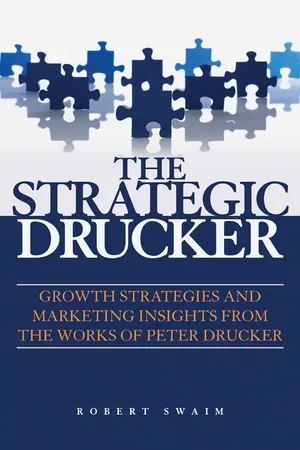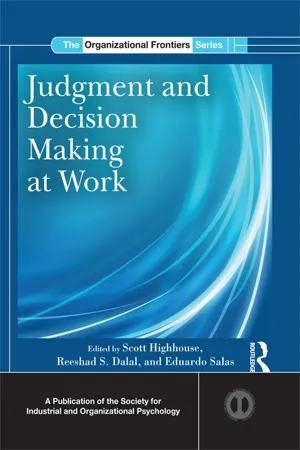Decision Making Model
A decision-making model in business refers to a structured approach used to make choices and solve problems. It typically involves identifying the decision to be made, gathering relevant information, evaluating alternatives, making a decision, and implementing and monitoring the decision's outcomes. This systematic process helps businesses make informed and effective decisions.
6 Key excerpts on "Decision Making Model"
- eBook - ePub
The Strategic Drucker
Growth Strategies and Marketing Insights from the Works of Peter Drucker
- Robert W. Swaim(Author)
- 2011(Publication Date)
- Jossey-Bass(Publisher)
...Model of Decision Making The Rational Model is described as a logical, step-by-step approach to decision making, with a thorough analysis of alternatives and their consequences. The characteristics of this model suggest the outcome will be completely rational (optimized), the decision maker uses a consistent system of preferences to choose the best alternative, the decision maker has complete information and is aware of all alternatives, and the decision maker can calculate the probability of success for each alternative. In summary, the model assumes the decision maker has complete information relative to the problem and unlimited time and resources to explore all possible alternatives that will arrive at an optimum decision. 12 Problems with the Rational Model As Drucker has described, decision makers are content to find an acceptable or reasonable solution versus the best or an optimal solution. Often there is either too much or too little information available, or the cost of obtaining the information can be too time consuming and expensive. We are therefore generally confined to the neighborhood of the problem’s symptoms as opposed to thinking outside the issue. As such, decision makers typically use their judgment instead of a defined prescriptive model. Bounded Rationality Model: Satisficing The Bounded Rationality Model suggests that there are limits upon how rational a decision maker can actually be. 13 The characteristics of this model are that managers suggest the first satisfactory alternative, they are comfortable making decisions without considering all the alternatives, and they make decisions by rules of thumb or “Availability or Representative Heuristics” (judgmental short cuts in decision making). 14 Availability Heuristics are judgments made on available information. As an example, people have a greater fear of flying than driving...
- eBook - ePub
The Psychology of Behaviour at Work
The Individual in the Organization
- Adrian Furnham(Author)
- 2012(Publication Date)
- Psychology Press(Publisher)
...This inverts the rule about problems requiring solutions but sees organizational decisions that search for a problem. When big organizations have many overlapping departments, task forces and committees with vague and overlapping responsibilities, there are too many people making decisions. Decision-makers have different goals and needs but cannot be involved in all decisions. Some try to influence others but often groups, like individuals, have competing priorities. Thus the same problem may be perceived quite differently by individuals who work against one another. Rational decision-making shows how decisions should be made, not how they are made. Case studies, even those with experts, show people to follow the bounded rationality model much more closely than the perfect rationality model. Johns (1992) has contrasted the two approaches. Thus, the perfect rationality model sees problem identification as accurate, easy and straightforward, and the bounded rationality model sees it as problematic – issues are ignored or downplayed, people jump too quickly to solutions, and there is attention to symptoms and not causes. Equally, the search for data in the perfect rationality model is fast, but in the bounded rationality model it is slow, costly, patchy and often insufficient. The perfect rationality model of decision evaluation states that the ultimate value of each is known, as is the probability, and the criterion of choice is based heavily on economic gain. The bounded rationality model stresses the potential ignorance or miscalculation of values and probabilities, and political and egocentric factors entering into the criterion of choice. There is evidence to suggest that people are as much rationalizing as rational. Psychologists have appeared to rejoice in revealing the mistakes of intuitive judgement or the inaccuracies in managers' everyday decision-making. There is a long list of errors, fallacies and biases of many managers...
- eBook - ePub
The Public Policy Primer
Managing the Policy Process
- Xun Wu, M. Ramesh, Michael Howlett, Scott A. Fritzen(Authors)
- 2017(Publication Date)
- Routledge(Publisher)
...Following instrumental thinking, the model proposes decision-makers should choose the option that maximizes the attainment of their individual goals and values (see Meyerson and Banfield 1955; Simon 1983). The model is “rational” in the sense that it can—at least in theory—lead to the most efficient possible means of achieving policy goals. Although the rational decision model is appealing due to its commitment to getting the job done, questions are raised about its neglect of ethics and democratic processes (DeLeon and Longobardi 2002; Garrison 2000; Richardson 2002). And critics also raise concerns about its practicality. The applicability of the model is hampered by the need for a large amount of accurate information on policy impacts and consequences of many possible policy alternatives—information that may be impractical or impossible to obtain in the usually short timeframe in which decision-makers must act. It also assumes a uniformity of purpose and framing of problems among decision-makers which may be lacking. Failing this unity, there will likely be no agreement on the basic criteria against which to assess a particular policy option. And decisions may be shared among many actors—many or all of whom are unwilling or unable to dispassionately weigh the aggregate costs and benefits of a particular decision. In such cases, the outcomes of a “rational” process are likely to be less optimal and efficient than expected or advertised. The limitations of the rational decision model, despite its seeming common-sense appeal, have led to a search for more holistic and normative policy theory (DeLeon and Longobardi 2002; John 1998; Parsons 1995; Sabatier 1999)...
- eBook - ePub
Strategic Decision Making for Successful Planning
Solving Problems for Great Results
- CJ Rhoads, William Roth(Authors)
- 2021(Publication Date)
- Productivity Press(Publisher)
...Chapter 6 Overview of the Ideal Decision Making Model DOI: 10.4324/9781003198062-6 Introduction The Ideal Decision Making Model (IDMM) is a ten-step model that can be used to diagram and make any type of business strategy decision that requires more than a superficial analysis and documentation to effectively reach the optimum solution. It is typically applied to autonomous work teams, but may also be applied by an individual decision maker. The steps in this process are sequential in nature, although some steps may be omitted or replaced as needed. The suggested ten steps are as follows: Document the decision to be made in a charter Identify the scope of the decision Collect initial data and survey the customers and stakeholders Define and diagram the process in order to understand current circumstances Establish the process performance measures and targets Diagram the causes and effects Collect data on causes Analyze data Develop and consider possible options Measure success or failure These ten steps can be grouped into six macro categories as follows: The decision to be made The process The causes The numbers The solution The future Understanding the Decision to Be Made In many cases, people often start improvement activities without first understanding why the decision must be made. Decisions almost always start with a problem to be solved. Often, people become uncomfortable and wonder whether or not the real or correct problem is being addressed or whether there will be a more important issue to work on right around the comer. Problem areas become much clearer when the actual circumstances are compared to the business objective, the process requirements, or the customer expectations. The bottom line is that problem areas must be “discovered.” Three steps are included in this category: (1) document the decision to be made in a charter, (2) identify the scope of the decision, and (3) review data on customers and stakeholders...
- eBook - ePub
The Essential Management Toolbox
Tools, Models and Notes for Managers and Consultants
- Simon Burtonshaw-Gunn(Author)
- 2009(Publication Date)
- Wiley(Publisher)
...In addition, as part of customer care training, many organizations are encouraged to ‘step into the customers’ shoes’ to identify and solve problems on behalf of their customers. Decision making and problem resolution should be considered to be not just a process to be deployed when issues need to be addressed but also a proactive way to promote innovation and encourage creativity within the organization. DECISION MAKING, PROBLEM SOLVING AND CONTINGENCY PLANNING This model shows a suggested linkage between the causes of past problems and an understanding of possible future problems which can provide information on which to undertake effective decision making. STEPS IN PROBLEM ANALYSIS AND DECISION MAKING An iterative process is shown in this model of problem analysis and decision making. The model offers a number of possible starting positions (★) depending on the level of information known about the problem. This model was published in The Management Task by Rob Dixon, 2002. Copyright Elsevier. TRADITIONAL FOUR STEP MODEL TO PROBLEM SOLVING While there are a number of ways to solve problems some solutions give rise to new problems. PROBLEM SOLVING PROCESS FROM INDUSTRIAL MANAGEMENT/WORK STUDY This approach to problem solving is taken from Industrial Management /Work Study from the mid to late 1970s; however, its concept still remains valid today. Previously there was often a focus on the immediate problem resolution with less thought applied to the maintenance and longer-term implications of such decisions. Today problem solving in business now considers to a far greater extent the longer-term product through life costs of such decisions. CAUSE AND EFFECT (FISHBONE) DIAGRAM The cause and effect diagram was devised by Kaoru Ishikawa, who pioneered quality management processes in the Kawasaki shipyards...
- eBook - ePub
- Scott Highhouse, Reeshad S. Dalal, Eduardo Salas, Scott Highhouse, Reeshad S. Dalal, Eduardo Salas(Authors)
- 2013(Publication Date)
- Routledge(Publisher)
...1 Introduction to Judgment and Decision Making Scott Highhouse, Reeshad S. Dalal and Eduardo Salas DOI: 10.4324/9780203767054-1 Most introductory chapters begin with a definition of the research area they are summarizing and applying. It seems difficult, however, to come up with a definition of judgment and decision making (JDM) research that is not tautological. We chose, therefore, to borrow (i.e., steal) a definition from another book on the topic. In Goldstein and Hogarth’s (1997) excellent book on the trends and controversies in JDM, the authors defined the psychology of judgment and decision making as the field that investigates the processes by which people draw conclusions, reach evaluations, and make choices. That seems as good as anything we might have come up with. But, there is something sterile and dissatisfying about this definition. It glosses over what Goldstein and Hogarth acknowledged is the broad and sometimes puzzling nature of a field that contains “a number of schools of thought that identify different issues as interesting and deem different methods as appropriate” (p. 3). The three editors of this volume, if pressed, will confess to being influenced by different streams of research and different perspectives on how JDM should be studied. The first and second editors (Highhouse and Dalal, respectively) identify most with the bounded rationality (Simon, 1957) perspective that is best exemplified by the heuristics and biases program of Kahneman, Slovic, and Tversky (1982) and the “everyday irrationality” perspective of Dawes (1988, 2001). These approaches see considerable value in understanding and improving JDM by focusing on how it may go wrong. This is often done in a decontextualized environment where specific processes may be isolated. Yet, the second editor is also somewhat sympathetic to approaches that focus on the adaptive nature of heuristics...





